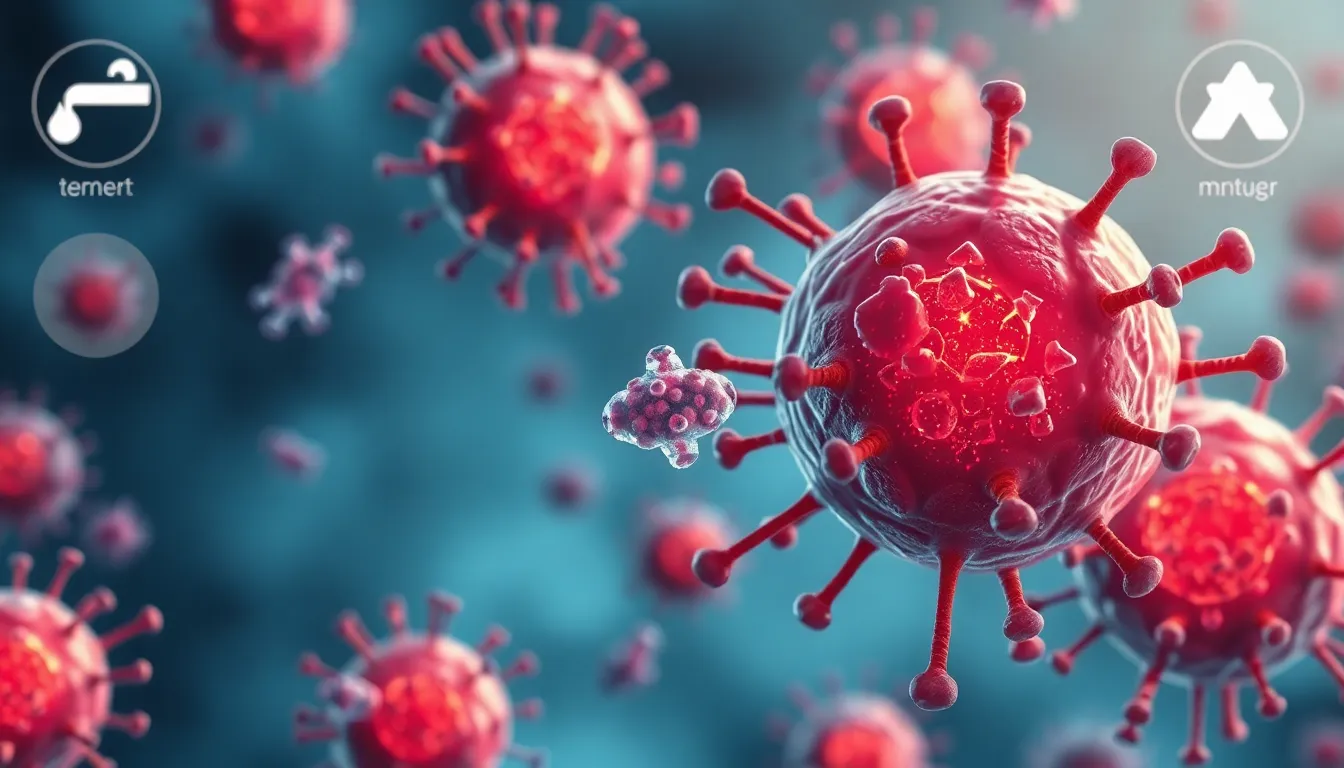In the ever-evolving world of science, few questions spark curiosity like the one about laturedrianeuro. This mysterious entity has captured the attention of researchers and casual observers alike. Could it be the next big thing in the realm of viral phenomena? Or is it just another passing fad, like pet rocks or mullets?
As they dig deeper into the topic, many wonder: can laturedrianeuro spread? The implications of this question stretch far beyond mere academic interest. Whether it’s a breakthrough in medicine or simply a quirky trend, understanding its potential to spread could hold the key to unlocking new possibilities. Join the exploration into this fascinating subject, where science meets intrigue and a dash of humor keeps things lively.
Can Laturedrianeuro Spread
Laturedrianeuro captivates researchers and the public alike due to its enigmatic nature. This entity raises significant questions regarding its classification, whether it falls under viral phenomena or simply trendy fads. Investigations into laturedrianeuro focus on its potential behaviors and impacts within biological systems.
Current theories propose that laturedrianeuro could influence various domains, including medicine, where understanding its mechanisms might lead to breakthroughs. Reports highlight observed patterns of laturedrianeuro that suggest it may spread under certain conditions if particular vectors are present.
Data collected from initial studies indicate various vectors may play crucial roles in the spread of laturedrianeuro, such as environmental influences and host interactions. Research teams evaluate these vectors in controlled environments to establish their impact more definitively.
Communities engaged in this exploration emphasize collaborative efforts, aiming to share findings that could clarify laturedrianeuro’s role in health and disease. The conversation surrounding it invites curiosity, urging experts across multiple fields to contribute knowledge and insights.
Studies suggest that laturedrianeuro’s effects might extend beyond immediate biological implications, prompting important discussions about public health strategies. Investigators encourage a multidisciplinary approach, integrating expertise in virology, epidemiology, and social science to fully understand the phenomenon.
As more information emerges, the complexity of laturedrianeuro unravels, revealing intricate connections that warrant further study. The fascination with laturedrianeuro continues to grow, fueled by the potential it holds for future research and discovery.
Mechanism of Spread

Understanding the mechanisms behind laturedrianeuro’s spread reveals significant insights into its biological and environmental interactions.
Biological Pathways
Laturedrianeuro may utilize several biological pathways for transmission. Cellular entry often occurs through receptor-mediated endocytosis, allowing the entity to infiltrate host cells effectively. Host cellular mechanisms then facilitate its replication and dissemination. Various studies indicate the involvement of immune responses, which can either hinder or aid in the spread. Significant factors include cytokine signaling, which can modulate the host’s defenses against laturedrianeuro. Additionally, horizontal gene transfer among microbial populations might enhance laturedrianeuro’s adaptability, enabling it to thrive in diverse environments. Understanding these pathways is critical, as they offer potential targets for therapeutic interventions.
Environmental Factors
Environmental factors play a crucial role in laturedrianeuro’s transmission dynamics. Temperature, humidity, and pollution levels significantly influence its viability and dispersal patterns. Certain studies report that elevated temperatures can enhance the replication rate of laturedrianeuro, increasing its spread during warmer months. Furthermore, urban settings often create favorable conditions for transmission due to higher population densities and interactions among hosts. Seasonal variations also impact the prevalence of laturedrianeuro, with some studies noting increased outbreaks during specific seasons. Overall, elucidating these environmental influences aids in predicting laturedrianeuro’s emergence and guiding public health responses.
Impact of Spreading
The spread of laturedrianeuro carries significant implications for both human health and ecological systems. Understanding these impacts is crucial for effective response strategies.
Human Health Implications
Laturedrianeuro’s spread raises concerns regarding potential health risks. Researchers suggest possible links to respiratory and neurological complications. Affected populations might exhibit varying symptoms, which depend on individual immune responses. Public health strategies must account for these risks to mitigate outbreaks effectively. Early detection systems play a vital role in monitoring the spread and protecting vulnerable communities. Collaboration between health organizations enhances preparedness and response efforts.
Ecological Consequences
The ecological impact of laturedrianeuro can disrupt local ecosystems. Changes in host populations may influence biodiversity levels within affected environments. Furthermore, the transmission dynamics can affect predator-prey relationships, leading to unforeseen consequences. Habitat destruction may exacerbate spread, enabling laturedrianeuro to thrive in new regions. Conservation efforts must adapt to these changes to maintain ecosystem balance. Understanding these ecological factors facilitates more effective management practices and promotes ecological resilience.
Current Research Findings
Recent studies illuminate the mechanisms behind laturedrianeuro’s spread, highlighting its interactions within biological and environmental frameworks. Evidence suggests it may employ multiple biological pathways for transmission, notably receptor-mediated endocytosis, which enables effective infiltration of host cells. Immune responses contribute significantly, with cytokine signaling either hindering or facilitating its spread.
Environmental conditions play a critical role in determining its viability and dispersal patterns. High levels of temperature, humidity, and pollution enhance the spread, particularly in urban regions during specific seasons. Understanding these aspects proves crucial for forecasting laturedrianeuro’s emergence and shaping effective public health strategies.
Significant health implications accompany the spread of laturedrianeuro, raising concerns about respiratory and neurological issues. Affected individuals display a range of symptoms, often dictated by their unique immune responses. Public health authorities need to implement strategies addressing these risks for effective outbreak mitigation. Early detection systems become essential tools for monitoring spread and safeguarding at-risk populations.
Ecological ramifications are also notable, as laturedrianeuro can disrupt local ecosystems. Changes in biodiversity and predator-prey dynamics emerge as potential consequences. Habitat destruction exacerbates its spread, allowing laturedrianeuro to colonize new areas. Conservation strategies must adapt to these evolving challenges, ensuring ecosystem balance remains intact. Addressing these ecological factors enhances management practices and fosters resilience in affected environments.
Future Directions in Study
Research initiatives are focusing on refining the methodologies used to study laturedrianeuro to enhance understanding of its spread and interactions. Collaborative efforts among scientists from various disciplines promote a better grasp of its biological mechanisms. By investigating environmental vectors like temperature and humidity, researchers aim to predict how laturedrianeuro may emerge under specific conditions.
Studies are utilizing advanced modeling techniques to simulate laturedrianeuro’s behavior in different ecosystems. Such simulations help clarify its impact on biodiversity and ecological stability. Genetic analyses of affected populations reveal variations in immune responses, emphasizing the need for targeted public health strategies.
Dialogue among public health officials and researchers strengthens the response to potential outbreaks. Incorporating real-time data analytics facilitates early detection and intervention strategies. As research evolves, understanding laturedrianeuro’s implications becomes crucial for both health and environmental conservation.
Further investigation into its interactions with human immune systems could unveil strategies for mitigating health risks. Predictive models are essential for planning responses to laturedrianeuro’s spread, ensuring preparedness for future scenarios. Strategies should integrate insights from ecological studies to foster a more comprehensive approach.
Understanding the connections among environmental factors, laturedrianeuro, and human health requires an interdisciplinary framework. Collaborations across fields will enhance knowledge sharing and innovation. These continued efforts are vital for shaping responses to laturedrianeuro’s challenges and opportunities in health and ecology.
Conclusion
The exploration of laturedrianeuro reveals its potential to impact both health and ecological systems significantly. As research progresses the understanding of its spread and mechanisms becomes clearer. This growing body of knowledge emphasizes the importance of interdisciplinary collaboration in addressing the challenges posed by laturedrianeuro.
Public health strategies must adapt to the evolving landscape shaped by laturedrianeuro. Early detection and targeted interventions are crucial in mitigating risks and protecting vulnerable populations. Additionally the ecological implications highlight the need for conservation efforts to maintain balance in affected ecosystems.
Continued investigation into laturedrianeuro promises to unveil critical insights that could lead to innovative solutions. The fascination surrounding this entity underscores the necessity for ongoing research and dialogue among experts, ensuring that both human health and environmental integrity are safeguarded.

